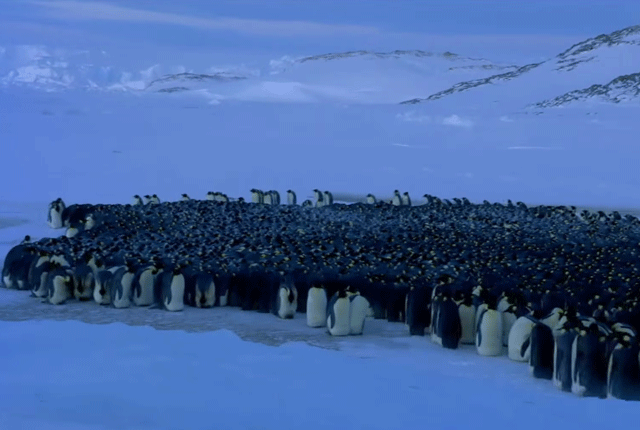
Emperor penguins huddle together for warmth during
those punishing Antarctic storms, taking turns being at the center of
the huddle. The social dynamics behind those huddles turns out to more
complicated than previously thought.
That’s in keeping with earlier work on how a single penguin can set off a “traveling wave” through the huddle. A few years ago, Daniel Zitterbart was in Antarctica conducting seismology research when he noted the huddling behavior of male emperor penguins, tasked with incubating the colony’s eggs. He thought it looked a lot like cell dynamics, so he videotaped the huddles and studied the time-lapsed footage when he returned home to the Alfred Wegener Institute in Germany. He found that huddled penguins don’t stand completely still. They move every minute or so, and when they do, all their nearest neighbors move with them.
Check out Zitterbart’s model of huddle behavior:
Why? It might have something to do with dispersing all that pent-up heat. It makes sense when you think about how the heat from all those penguin bodies must be building up, especially at the center of the huddle. Ancel et al. estimate that temperatures can be as high as 100 degrees there — a bit too toasty for a penguin’s comfort. In fact, “The breakup of huddles is sometimes accompanied by a haze of warm air rising over the colony, which indicates a significant dissipation of heat,” Ancel et al. write. They even observed some penguins eating snow after getting out of the huddle, presumably to cool off faster.
So the penguin at the center of the huddle doesn’t really have the sweetest spot, at least not once the heat starts to build. Yet the Strasbourg scientists found that while it only took one penguin to start a chain reaction that broke up the huddle — or, in one memorable case, two penguins getting into a fight — that penguin was rarely the one in the center. Usually it was a penguin on the edge of the huddle that peeled away first.
References:
Ancel, Andre et al. (2015) “New insights into the huddling dynamics of emperor penguins,” Animal Behaviour 110: 91-98.
Gerum, R.C. et al. (2013) “The origin of traveling waves in an emperor penguin huddle,” New Journal of Physics 15.
Gilbert, C. et al. (2006) “Huddling behavior in emperor penguins: dynamics of huddling,” Physiology & Behavior 88: 479-488.
Waters, A., Blanchette F., and Kim, A.D. (2012) “Modeling huddling penguins,” PLoS ONE 7: e50277.
Zitterbart, D.P. et al. (2011) “Coordinated movements prevent jamming in an Emperor penguin huddle,” PLoS ONE 6: e20260.
[Via Mental Floss]
Image: Still from PBS’ The Gathering Swarms (2014).
source

















No comments:
Post a Comment